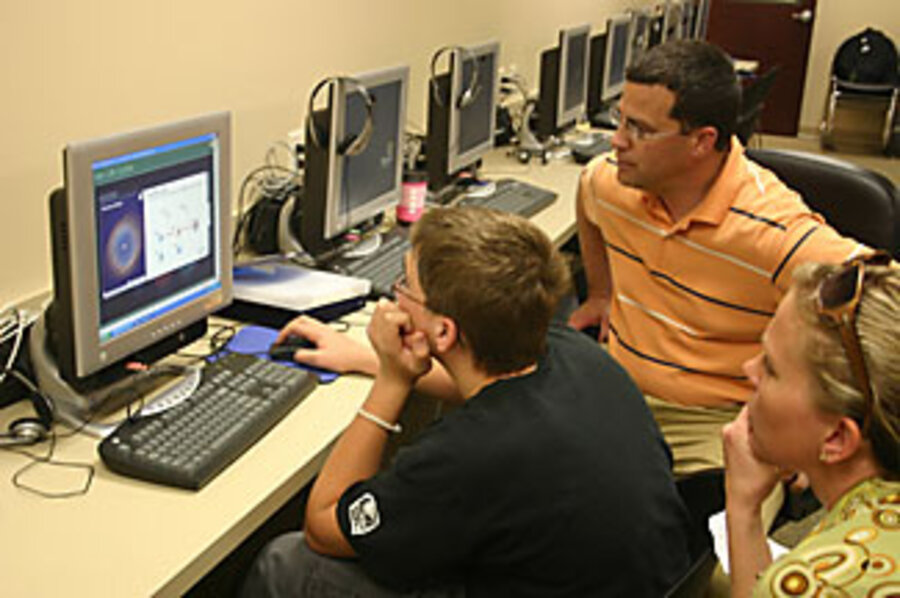Virtual schools see strong growth, calls for more oversight
Loading...
| Meridian, Idaho
Rather than send her kids off on the yellow bus, Briana LeClaire has school come to her home. Her kids attend a virtual public school, connecting online to teachers and coursework. Everything from books to microscopes to radish seeds arrives via brown trucks.
Mrs. LeClaire describes it as the 21st-century, middle-class version of the private tutor. Her 6th-grader can move quickly through her strong subjects, such as literature, and spend more time on her weaker areas, like math.
Enrollment in online classes last year reached the 1 million mark, growing 22 times the level seen in 2000, according to the North American Council for Online Learning. That's just the start, says a new paper by the Hoover Institute, a conservative think tank at Stanford University. Its authors predict that by 2019 half of courses in Grades 9 to 12 will be delivered online.
The efficiency of online learning accounts for this growth. But there's little research assessing the quality of these programs, which some experts say don't have enough official oversight.
Under the federal No Child Left Behind law, "you have to have high standards, tight oversight, scrutiny over what teachers are doing. Yet on the other extreme, also promoted by the federal government, are these loosely accountable approaches to schooling," says Luis Huerta, a professor at Columbia University's Teachers College who has researched virtual schools for more than a decade.
Even some supporters of online learning say education officials need to provide more guidance. Some states allow online Advanced Placement (AP) courses; some don't. Ditto for requiring lab work in science courses. The inconsistencies stunt the online model's growth, says David Reed, a researcher at Arizona State University in Tempe.
Among the oversight questions is how to track attendance. Most states mandate a minimum number of hours of instruction. At Idaho Virtual Academy, the school the LeClaires attend, it falls on parents to submit a weekly log of their child's hours.
What counts as learning time is open to interpretation. A teacher at the academy suggested that a family's Bible reading could count. But Tamara Baysinger, a state official who oversees virtual schools, says parents can't count time spent on curriculum not provided by the school. Computer log-ins provide some objective accounting. "There are monitoring systems in place where they can't just log on and go watch television," says Ms. Baysinger.
Mr. Reed suggests a better way to account for learning: Keep track of course material completed, not number of hours of instruction.
"If I've got a kid who's taken algebra three times and failed it three times, what is the point of putting him in another 90-hour class?" says Reed, who works for a private virtual school. "The Web course allows you to isolate the need and do it quicker, but [schools] don't want to do that because dollars are tied to seat time."
There's also debate over how much public funds go to virtual schools. Dr. Huerta's research revealed school districts that championed new virtual charter schools to collect per-pupil funding for students who cost less to educate.
Huerta identified a virtual school in California that was little more than a shipping warehouse with fewer than 10 teachers for 1,500 students: "There was virtually no overhead, and the district got to keep the rest of the money."
California now gives only a fraction of per-pupil money for virtual school enrollments. Idaho offers the full amount, but requires virtual charter schools to pay for their own facilities.
"We are providing cost savings to the taxpayers because we are running 35 percent cheaper," says Cody Claver, the head of Idaho Virtual Academy. The school enrolls 2,000 students, employs 75 teachers and staff, and maintains an attractive facility where students can come in for testing or weekly special needs help. Its graduates earn diplomas, just as students in traditional schools do.
Online education is set to surge, says the Hoover report, because of these cost savings and the flexibility to tackle unmet needs in the traditional system, such as AP courses.
Teachers in traditional schools "don't have a lot of time to be a tutor, mentor, or motivator because so much of their time is spent delivering one-size-fits-all lectures," says Michael Horn, executive director of education at Innosight Institute and a report coauthor. If computers take over lecturing, teachers can work with those who need help. "It can change our assumption of what teacher-student ratios make sense."
The report's growth projection met with mixed responses from experts.
"They could be on to something there" for subjects like math and spelling, says Gene Glass, an education professor at Arizona State. "Then there's the other half of the curriculum that you're never going to put on a machine: art, literature, a whole bunch of things that depend so much on a quality human relationship."
Huerta worries that the report's authors have confused efficiency with quality. "There has been no valid study showing that children participating in virtual or computer-based learning models are performing any better than in traditional schools," he says.
Reed's research in Arizona, involving 1,200 grades given in online courses, indicates that student performance has little to do with whether the lessons come online or in a classroom. "The method of delivery isn't the issue – it's the student," says Reed.
In Idaho, all four statewide virtual charter schools failed this year to meet annual progress targets on standardized testing. But so did 70 percent of all Idaho schools.
At Idaho Virtual Academy, teachers monitor student progress by tracking their performance on quizzes after new lessons. "It's not overly absurd for a kid to show up in a brick-and-mortar school and do practically nothing," says Mr. Claver. "In our school, it is out of the realm of possibility."





